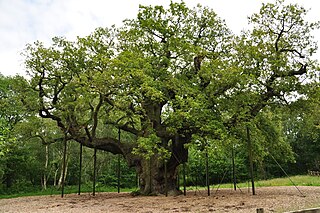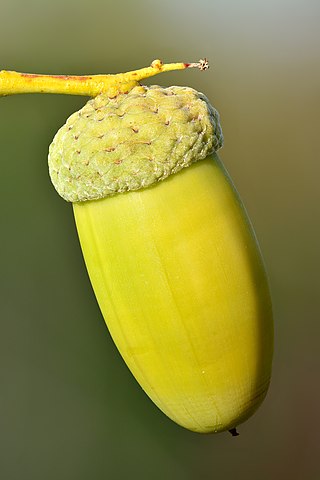
An oak is a tree or shrub in the genus Quercus of the beech family, Fagaceae. There are approximately 500 extant species of oaks. The common name "oak" also appears in the names of species in related genera, notably Lithocarpus, as well as in those of unrelated species such as Grevillea robusta and the Casuarinaceae (she-oaks). The genus Quercus is native to the Northern Hemisphere and includes deciduous and evergreen species extending from cool temperate to tropical latitudes in the Americas, Asia, Europe, and North Africa. North America has the largest number of oak species, with approximately 160 species in Mexico, of which 109 are endemic and about 90 in the United States. The second greatest area of oak diversity is China, with approximately 100 species.

Quercus alba, the white oak, is one of the preeminent hardwoods of eastern and central North America. It is a long-lived oak, native to eastern and central North America and found from Minnesota, Ontario, Quebec, and southern Maine south as far as northern Florida and eastern Texas. Specimens have been documented to be over 450 years old.

Pasadena is a city in the U.S. state of Texas, within the Houston–The Woodlands–Sugar Land metropolitan area. As of the 2020 U.S. census, the city's population was 151,950, making it the twentieth most populous city in the state of Texas, as well as the second-largest city in Harris County. The area was founded in 1893 by John H. Burnett of Galveston, who named the area after Pasadena, California, because of the perceived lush vegetation.

Quercus velutina, the black oak, is a species of oak in the red oak group, native and widespread in eastern and central North America. It is sometimes called the eastern black oak.

Quercus robur, the pedunculate oak, is a species of flowering plant in the beech and oak family, Fagaceae. It is a large tree, native to most of Europe and western Asia, and is widely cultivated in other temperate regions. It grows on soils of near neutral acidity in the lowlands and is notable for its value to natural ecosystems, supporting a very wide diversity of herbivorous insects and other pests, predators and pathogens.

Quercus garryana is an oak tree species of the Pacific Northwest, with a range stretching from southern California to southwestern British Columbia. It is commonly known as the Oregon white oak or Oregon oak or, in Canada, the Garry oak. It grows from sea level to an altitude of 690 feet in the northern part of its range, and from 980 to 5,900 ft in the south of the range in California. The eponymous Nicholas Garry was deputy governor of the Hudson's Bay Company.

Quercus virginiana, also known as the southern live oak, is an evergreen oak tree endemic to the Southeastern United States. Though many other species are loosely called live oak, the southern live oak is particularly iconic of the Old South. Many very large and old specimens of live oak can be found today in the Deep South region of the United States.

The Major Oak is a large English oak near the village of Edwinstowe in the midst of Sherwood Forest, Nottinghamshire, England. According to local folklore, it was Robin Hood's shelter where he and his merry men slept. It weighs an estimated 23 tons, has a girth of 33 feet, a canopy of 92 feet, and is about 800–1,000 years old. In 2014, it was voted 'England's Tree of the Year' by a public poll by the Woodland Trust, receiving 18% of the votes. Its name originates from Major Hayman Rooke's description of it in 1790.

Quercus agrifolia, the California live oak, or coast live oak, is a highly variable, often evergreen oak tree, a type of live oak, native to the California Floristic Province. It may be shrubby, depending on age and growing location, but is generally a medium-sized tree. It grows west of the Sierra Nevada mountain range from Mendocino County, California, south to northern Baja California in Mexico. It is classified in the red oak section of oaks.

Quercus fusiformis, commonly known as escarpment live oak, plateau live oak, plateau oak, or Texas live oak, is an evergreen or nearly evergreen tree. Its native range includes the Quartz Mountains and Wichita Mountains in southwestern Oklahoma, through Texas, to the Mexican states of Coahuila, Tamaulipas, and Nuevo León.

Enchanted Rock is a pink granite mountain located in the Llano Uplift about 17 miles (27 km) north of Fredericksburg, Texas and 24 miles (39 km) south of Llano, Texas, United States. Enchanted Rock State Natural Area, which includes Enchanted Rock and surrounding land, spans the border between Gillespie and Llano counties, south of the Llano River. Enchanted Rock covers roughly 640 acres (260 ha) and rises around 425 feet (130 m) above the surrounding terrain to an elevation of 1,825 feet (556 m) above sea level. It is the largest pink granite monadnock in the United States. Enchanted Rock State Natural Area, a part of the Texas state park system, includes 1,644 acres (665 ha). In 1936, the area was designated a Recorded Texas Historic Landmark. In 1971, Enchanted Rock was designated as a National Natural Landmark by the National Park Service.

The acorn, or oaknut, is the nut of the oaks and their close relatives. It usually contains one seed, enclosed in a tough, leathery shell, and borne in a cup-shaped cupule. Acorns are 1–6 cm long and 0.8–4 cm on the fat side. Acorns take between 5 and 24 months to mature; see the list of Quercus species for details of oak classification, in which acorn morphology and phenology are important factors.
Newbury Park is a populated place and town in Ventura County, California, United States. Most of it lies within the western Thousand Oaks city limits, while unincorporated areas include Casa Conejo and Ventu Park. The town is located in Southern California around 8 miles from the Pacific Ocean and has a mild year-round climate, scenic mountains, and environmental preservation. About 28,000 residents of Thousand Oaks reside in Newbury Park.

The Treaty Oak is an octopus-like Southern live oak in Jacksonville, Florida. The tree is estimated to be 250 years old and may be the single oldest living thing in Jacksonville, predating the founding of the city by Isaiah Hart during the 1820s. It is located in Treaty Oak Park in the Southbank area of Downtown Jacksonville.

The Tree That Owns Itself is a white oak tree that, according to legend, has legal ownership of itself and of all land within eight feet (2.4 m) of its base. Also known as the Jackson Oak, the tree is at the corner of South Finley and Dearing Streets in Athens, Georgia, US. The original tree, thought to have started life between the mid-16th and late 18th century, fell in 1942, but a new tree was grown from one of its acorns and planted in the same location. The current tree is sometimes referred to as the Son of the Tree That Owns Itself. Both trees have appeared in numerous national publications, and the site is a local landmark.

Visalia, California, commonly known in the 1850s as Four Creeks, is the oldest continuously inhabited inland European settlement between Stockton and Los Angeles. The city played an important role in the American colonization of the San Joaquin Valley as the county seat of Old Tulare County, an expansive region comprising most if not all of modern-day Fresno, Kings, and Kern counties.

Quercus arizonica, the Arizona white oak, is a North American tree species in the beech family. It is found in Arizona, New Mexico, western Texas, Sonora, Chihuahua, Coahuila, Sinaloa, and Durango.

Tebuthiuron is a nonselective broad spectrum herbicide of the urea class. It is used in a number of herbicides manufactured by Dow AgroSciences, and is sold under several trade names, depending on the formulation. It is used to control weeds, woody and herbaceous plants, and sugar cane. It is absorbed by the roots and transported to the leaves, where it inhibits photosynthesis.

Walnut Grove Park is a 6.5 acre community park in Newbury Park, California, United States, situated immediately south of the U.S. 101 Ventura Freeway on Newbury Road. Named for its many walnut trees, the park land was acquired in 1981 and ultimately developed into a community park in 1994. It contains a playground, an outdoor handball court, three BBQ grills, basketball courts, numerous picnic tables, trails, and open-space. It is operated by the Conejo Recreation & Park District (CRPD), and it is adjacent to the Walnut Grove Equestrian Center and its 14 acres of trails, horse arenas, stalls, picnic tables, and various trails for hikers and equestrians. The park is relatively close to the Arroyo Conejo Open Space and its many trails leading for instance to Wildwood Regional Park, which is accessible from its closest trailhead between 507 Kalinda Pl. and 504 Paseo Grande on West Hillcrest Drive. Walnut Grove Park is located along a smaller offspring from the Arroyo Conejo, and is one of only three off-leash dog parks in the Conejo Valley.

The Henry W. Maxwell Memorial is a public memorial located in Brooklyn's Grand Army Plaza in New York City. The memorial, designed by sculptor Augustus Saint-Gaudens, consists of a bronze tablet featuring a relief of Maxwell, a local philanthropist and park commissioner, affixed to a boulder. The memorial was dedicated in 1903 at the intersection of Eastern Parkway and Flatbush Avenue. In 1912, the memorial was moved to its present location at Grand Army Plaza. In the 1970s, due to vandalism, the plaque was removed and placed in storage, with a replacement plaque affixed to the boulder in 1996. The original plaque is located in the Brooklyn Museum.



















